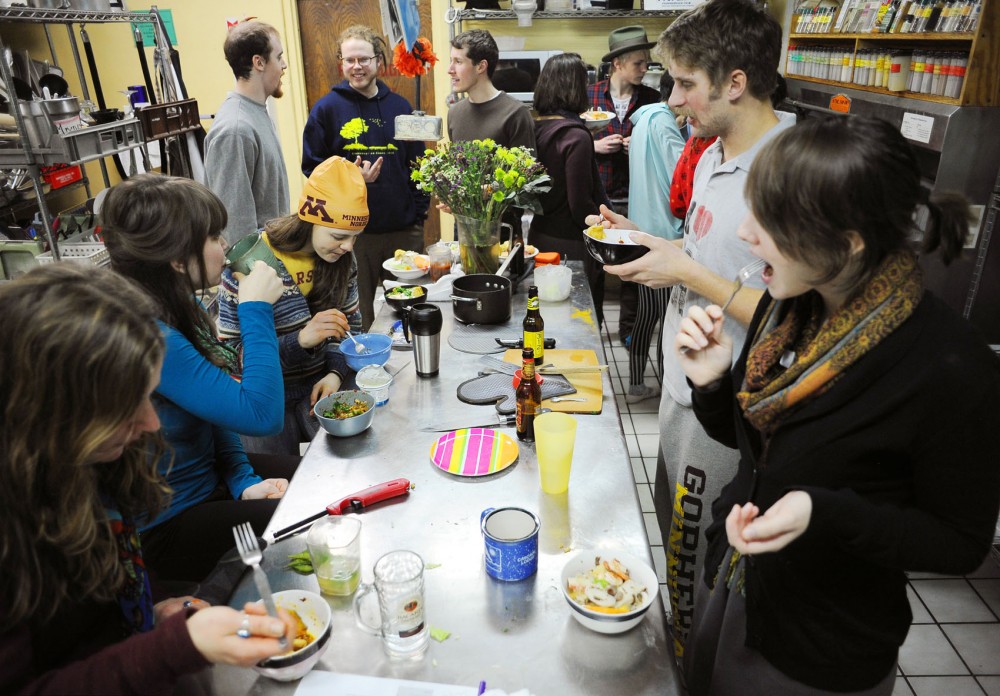At the University of Minnesota’s Students’ Co-op, the kitchen is the heart of the beast. Racks of spices, containers of grains and a hodgepodge of cans and boxes sit across from a wall dotted with painted stars.
The co-opers pull tofu out from industrial-sized fridges and plop dishes in equally huge sinks. They prop their elbows on the counter to grab a bite over an hour or two of socializing.
In a house full of bike racks, mismatched furniture and murals, it seems it all belongs to no one and yet to everyone.
It’s that sense of sharing and pooling of resources that influenced the group of 29 students and alumni to vote to officially support the Save Dinkytown coalition. The two groups oppose changes to the zoning and character of Dinkytown.
The Save Dinkytown group began in response to the forthcoming Opus development, which will replace the building that holds House of Hanson, Book House and The Podium. No other student group on campus has officially supported the coalition.
Resident and University alumna Jilla Nadimi said there’s a perception that needs to change that students aren’t invested in their communities.
“If you invest in your students, they will invest back in the community,” she said. “We’ve seen that.”
Student cooperatives are the polar opposite of luxury apartment projects like Opus’, said co-op President Corey Poland.
The cooperative, which sits in the middle of University Avenue’s greek stretch, was originally a fraternity house.
During World War II, all but two of the Psi Upsilon chapter members enlisted, forcing the conversion of the former fraternity into the existing cooperative in 1940.
The co-op members each own a share of their University Avenue home, which allows them to set low rent rates — $300 per month on average with a meal plan included.
The cooperative structure, Poland said, is a student housing model worthy of investment.
The University district’s heavy development could also affect the co-op in other ways, said member Ryan Below, by raising property taxes and threatening historical buildings — like the co-op’s 105-year-old house.
Rebecca Orrison, another student co-oper, said she worries more about the effect of razing older buildings and replacing them with new ones.
She pointed to Loring Pasta Bar’s renovation of an old drugstore as the kind of development she wants to see more.
“That’s the kind of evolution that allows you to still appreciate the character and historic value of Dinkytown, rather than a Walgreens down the street from a CVS and a six-story shadow cast over Fourteenth [Avenue] and Fifth Street,” Orrison said.
The cooperative model
The cooperatives near campus have a vested interest in the increased development because they’re so rare. But at other large universities, like the University of Wisconsin-Madison and the University of Michigan, cooperatives are well-established on campus.
Founding a new co-op on campus requires finding the funds to buy the right kind of building outright, Below said.
Oftentimes, he said cooperatives search for large, abandoned buildings to purchase — which is made difficult at the University because large buildings are often purchased to tear down and develop into newer projects.
Funding a new co-op is also difficult because the real estate and financing markets often overlook cooperatives, said Ryan Allen, associate professor at the Humphrey School of Public Affairs.
“[In] today’s real estate market, the cooperative structure is sort of an afterthought,” he said. “You either rent or you own, those are kind of the options you have.”
Since cooperative houses are bought outright, Allen said, there’s no payoff for a bank to help finance the original purchase of a house.
Co-opers are skeptical of luxury housing because of the high cost of living, loss of green spaces around campus and the lack of diversity.
“There’s been a redefinition of what it means to have affordable housing,” Orrison said. “There’s an expectation you’re going to have to take out loans to pay for the cost of living.”
An excess of luxury housing influences student’s expectations, Nadimi said.
“If you’re going to be more surrounded by luxury apartments, you’re going to think that that’s a standard way of living,” she said. “You are going to want that.”
Sharing space, resources, culture
Sharing is more than just caring for the cooperative members: It’s a way of life.
Food, furniture, appliances and their three bathrooms are shared by 29 people.
“It’s really satisfying to live with people, to share our resources, to share our food, to share our time and to build back up this house — a place we all love and cherish,” said house member Jennifer Schreiter .
Sharing resources also has ecological benefits, said Robin Welling, a biological sciences junior.
“I like the idea of having a smaller environmental impact,” she said.
For Below, it’s the sharing of culture that makes the cooperative experience so valuable.
The co-op is home to people from Malaysia, Canada, Somalia and Belarus and is not limited to students.
Allen said cooperatives are useful places for learning, since students manage a property on their own, with an equal stake in major decisions.
“It’s a good model for helping people learn how to operate in a democratic society,” he said.
It’s also certified by the North American Students of Cooperation, which means it’s only one of hundreds of co-ops across the country.
Within the national NASCO community, houses pool their resources. The University’s house has lent money to other co-ops for things like food — and now that they’re looking to expand, they said they’d rely on those connections.


